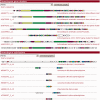antiSMASH 2.0--a versatile platform for genome mining of secondary metabolite producers
- PMID: 23737449
- PMCID: PMC3692088
- DOI: 10.1093/nar/gkt449
antiSMASH 2.0--a versatile platform for genome mining of secondary metabolite producers
Abstract
Microbial secondary metabolites are a potent source of antibiotics and other pharmaceuticals. Genome mining of their biosynthetic gene clusters has become a key method to accelerate their identification and characterization. In 2011, we developed antiSMASH, a web-based analysis platform that automates this process. Here, we present the highly improved antiSMASH 2.0 release, available at http://antismash.secondarymetabolites.org/. For the new version, antiSMASH was entirely re-designed using a plug-and-play concept that allows easy integration of novel predictor or output modules. antiSMASH 2.0 now supports input of multiple related sequences simultaneously (multi-FASTA/GenBank/EMBL), which allows the analysis of draft genomes comprising multiple contigs. Moreover, direct analysis of protein sequences is now possible. antiSMASH 2.0 has also been equipped with the capacity to detect additional classes of secondary metabolites, including oligosaccharide antibiotics, phenazines, thiopeptides, homo-serine lactones, phosphonates and furans. The algorithm for predicting the core structure of the cluster end product is now also covering lantipeptides, in addition to polyketides and non-ribosomal peptides. The antiSMASH ClusterBlast functionality has been extended to identify sub-clusters involved in the biosynthesis of specific chemical building blocks. The new features currently make antiSMASH 2.0 the most comprehensive resource for identifying and analyzing novel secondary metabolite biosynthetic pathways in microorganisms.
Figures



References
-
- Scheffler RJ, Colmer S, Tynan H, Demain AL, Gullo VP. Antimicrobials, drug discovery, and genome mining. Appl. Microbiol. Biotechnol. 2013;97:969–978. - PubMed
-
- Zotchev SB, Sekurova ON, Katz L. Genome-based bioprospecting of microbes for new therapeutics. Curr. Opin. Biotechnol. 2012;23:941–947. - PubMed
-
- Medema MH, Breitling R, Bovenberg R, Takano E. Exploiting plug-and-play synthetic biology for drug discovery and production in microorganisms. Nat. Rev. Microbiol. 2011;9:131–137. - PubMed
Publication types
MeSH terms
LinkOut - more resources
Full Text Sources
Other Literature Sources
Molecular Biology Databases

